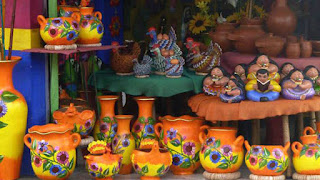SUN &BEACH ROUTE
BEACHES OF EL SALVADOR
El Salvador offers visitors more than 300 Km .
Of beautiful tropical beaches . Among them, two of the world's best beaches for
surfing : beaches El Sunzal and La Paz.
From the west to the east of the country there
are more than 45 beaches with colorful landscapes , where you can enjoy warm
waters , intense sun and awesome waves that attract surfers from around the
world.
PEACE ROUTE
 |
| Agregar leyenda
|
This route provides
the opportunity to meet the contemporary history of El Salvador, inherited
cultural roots of the ancient indigenous people of Lenca origin. The villages
that make up the path of peace have deeply rooted traditions of their ancestors
settlers, which can be seen in the daily life of the inhabitants of these
villages .
Peace Route is made by
the people of Perquin ,Arambala , Villa El Rosario , Joateca , Cacaopera and
Corinth . Here , you can enjoy a natural paradise and learn the history and
culture of our ancestors , their indigenous traditions , living nature , fresh
air . It is a lovely place to discover him and to delve into an unforgettable
adventure spot .
This route has been
named this way for a period of tranquility enjoyed in the area, after 12 years
of civil war ; as this area was one of the main scenes of great battles . The
path of peace is located in the department of Morazán and includes a number of
different peoples. Morazan department is located in the eastern part of El
Salvador; his departmental head is San Francisco Gotera , located 167 kms from
the city of San Salvador .
FLOWERS
ROUTE
Nice drive from
Sonsonate to Ahuachapán comprising 5 main destinations :Salcoatitán ,
Nahuizalco , Juayua, Apaneca and Ahuachapan .
All are places of
incomparable natural beauty , enjoy a pleasant climate , fertile lands that
show a colorful journey with the mixture of aromas in the area. On weekends you
can enjoy the gastronomic fairs in different towns that make up this route
where you will find exotic and delicious national and international dishes , or
horse riding , carriages and a small train that runs through the city of Juayúa
.
You can visit many
traditions and culture, activities such as the production of wicker furniture
and crafts , crafts made with Indigo, Looms or a delicious coffee. A others
in the area can perform activities such as rappel and canopy .
COFFEE
ROUTE
Salvadoran Coffee
forest, has exuberant biodiversity, history, traditions, folklore and a culture
of work. This way of life and work can be experienced by tourists to be part of
the collection (harvesting), beneficiation and processing of coffee; although
the process starts from the crop. The grand finale is to finish enjoying an
excellent cup of coffee, you surely will not want to miss.
ARTISAN
ROUTE
 Come and visit
picturesque villages of El Salvador where people produce priceless works of
art, let yourself be enchanted by the magic of our crafts.
Come and visit
picturesque villages of El Salvador where people produce priceless works of
art, let yourself be enchanted by the magic of our crafts.
Salvadoran artisans
work clay, natural fibers, wood , seeds and fabrics authentic and beautiful .
La Palma ,Ilobasco and San Sebastian are some of the representatives of the
Salvadoran crafts.
ARCHAEOLOGICAL
TOUR
El Salvador there are
numerous archaeological sites that are part of the RutaMaya . The Maya ,Pipil
and Lenca , civilizations formed their settlements in this land , where some of
their ceremonial centers are still preserved such as :
ARCHAEOLOGICAL SITE JOYA DE CEREN
Located in the
department of La Libertad, Jewel Cerénunos 30 minutes from the capital , it was
declared a World Heritage Site by UNESCO in 1993. This site shows the daily
life of its indigenous inhabitants , interrupted by the eruption of the volcano
Loma Caldera in the year 600 AD approximately.
ARCHAEOLOGICAL SITE
SAN ANDRES
Away from Joya de
Ceren , is this ceremonial archaeological site. San Andrés was the regional
alderman ceremonial and administrative center between 600-900 D.C. There is an
obraje indigo dating from the colonial era and was buried by the eruption of
Volcano Playon in the year 1658 A.D. It has been a place of important findings
, including a religious scepter made in flint and skulls with dental inlays.
TAZUMAL
The first reference
dates back to 1892 and was formally registradoTazumal in 1940. The occupation
of Tazumal is believed began in 1200 B.C. Its structure is a little over 24
meters. high and comprises 12 steps or pallets . Within her tombs they were
found with more than 116 vessels , jade jewelry , iron pyrite mirrors ,
artifacts ballgame and shaped ceramic lizard.
























